Must-Have Construction Software Buyer’s Guide & Checklist
If you’re on the hunt for new construction management software, you’ve probably noticed that there are more options than ever. Research analysts predict that construction technology tools will continue to see steady growth until 2025. With the market being flooded with an overwhelming number of options, construction firms need to be strategic when it comes to picking software solutions that provide a return on investment. And “investment” is the key word to remember, rather than evaluating construction software as a one-time buy.
Fortunately, we’ve released a new construction software buyer’s guide to help you successfully evaluate and choose the right tools for your firm.
Download Ebook
Pair our buyer’s guide with this checklist to jump start the evaluation process and select the best construction software to fit your needs. Download the free checklist now to get started.
DOWNLOAD CHECKLIST
What are some must-haves when selecting construction software?
Cloud-based with Centralized Data
As a top priority, your construction software should be cloud-based. This is a key element of modern collaboration in construction. Firms that have adopted cloud-based construction software reap the benefits of streamlined workflows, greater productivity, and higher visibility into their projects.
What makes choosing a solution in the cloud so essential? Cloud-based software works from anywhere, reflecting the way people work today. Teams can work collaboratively in real time, or even offline when in remote locations. And as soon as you’re connected again, all your work will sync seamlessly to the project. Using cloud services isn’t only about data storage and digitizing workflows. It’s about embracing a new way of working—one where accessibility, automation, and collaboration come first.
Instead of manually moving documents to and from the cloud, your team will work together on improving existing processes and workflows, allowing for greater efficiency and less waste.
Made for Mobile
Construction teams are always on the go. Whether you’re in the field or in an office, you’ll probably still move between multiple locations throughout the day. You should be able to take your work with you and access it on the go. For teams in the field, it’s especially important to have mobile access to documents, as well as advanced functionality to collaborate in real time.
When searching for construction management software, make sure it’s natively mobile. That means the solution was purpose-built for mobile devices. If you pick a solution that isn’t built for mobile devices, you’ll find it is too difficult for teams to adopt and use. Tools that are built for desktop and then retrofitted to work for mobile don’t provide a seamless, intuitive user experience. Simply put, tools that are difficult to use are far less likely to be adopted by your team.
Easy-to-Use with Intuitive Interface
Make sure your construction software has an intuitive interface. It must be easy to use. Solutions that require extensive training for mastery only cause frustration, even for power users. Your teams will be relying on this software, often on the go, so accessing important information must be simple and fast. Look for construction software that makes it easy for your team to input data, provide updates, and exchange project-critical information.
Look for a Connected Cloud Environment
As your firm grows, your technology needs will evolve, and your construction management software needs to support that growth. To make scalability possible, avoid using disconnected point solutions that put critical data into silos. But we’re talking about more than just a cloud-based solution here. Rather, you want to look for a more comprehensive construction software solution that connects all your processes with a single environment. With so many workflows in construction relying on accurate, real-time data, when decision-making matters most, you want to respond quickly. However, it can take days, weeks or even months to clean, compile and analyze project-critical data. No one wants to halt a project because a decision can’t be made.
Your ideal cloud environment for construction will bring all of your key project data into a single source. Whichever tool you choose should leverage what is called a common data environment, or CDE. This serves as your foundation for more profitable projects because everyone—from design and planning to construction and handover—is looking at the same reliable data to make decisions. You’ll be able to review insights, analyze data, collaborate with stakeholders, and make accurate forecasts. The right solution for your firm not only works today, but far into the future.
Supports Robust Integrations
With the sheer volume of technology supporting the industry today, the truth is there’s no single solution that can “do it all”. Identifying a software partner that supports a robust integration ecosystem is important, but must also provide meaningful ways to share data across all your teams’ tools.
If data cannot be shared in a useful way, or made accessible in a practical format, your integrations are more likely to hold you back. On top of that, you’ll want integrations that are actively supported for years to come as the industry, and your own technology needs evolve.
Backed by Cutting-edge Technology
In the future of construction, we’ll continue to see predictive analytics, machine learning, and AI play a significant role. The best construction software solutions integrate these advancements into their technology ecosystem so you can quickly convert data into actionable insights.
Partnership with Your Software Solution Provider
You need more than ‘just a software solution’ to stay competitive and extract the most value out of your project data. Additionally, your software provider should serve as a partner who is invested in your long-term success. They’ll be there as a guide and educator, offering training and support whenever questions come up.
Download the Buyer’s Guide Today
These features are all essential in a construction management software solution. To learn more about evaluating construction software and round out your list of must-haves, download our buyer’s guide and checklist.
Download Buyer’s Guide
Download Checklist
The post Must-Have Construction Software Buyer’s Guide & Checklist appeared first on Digital Builder.
5 Reasons Construction Pro’s Should Not Miss Autodesk University 2021
Autodesk University (AU) is back and better than ever. AU 2021 is about empowering you to take the reins and build the world you want to see. It’s why our leading mantra this year is Don’t wait for progress. Make it. And we’re here to equip you with expert-led classes, panels, meetups, workflow education, product demos, and more. Achieving your goals is our top priority. This zero-cost digital conference runs from October 5 – 7 for those in the Americas. More dates for international attendees below. This is one construction event you do not want to miss, and it only comes around once a year.
REGISTER NOW
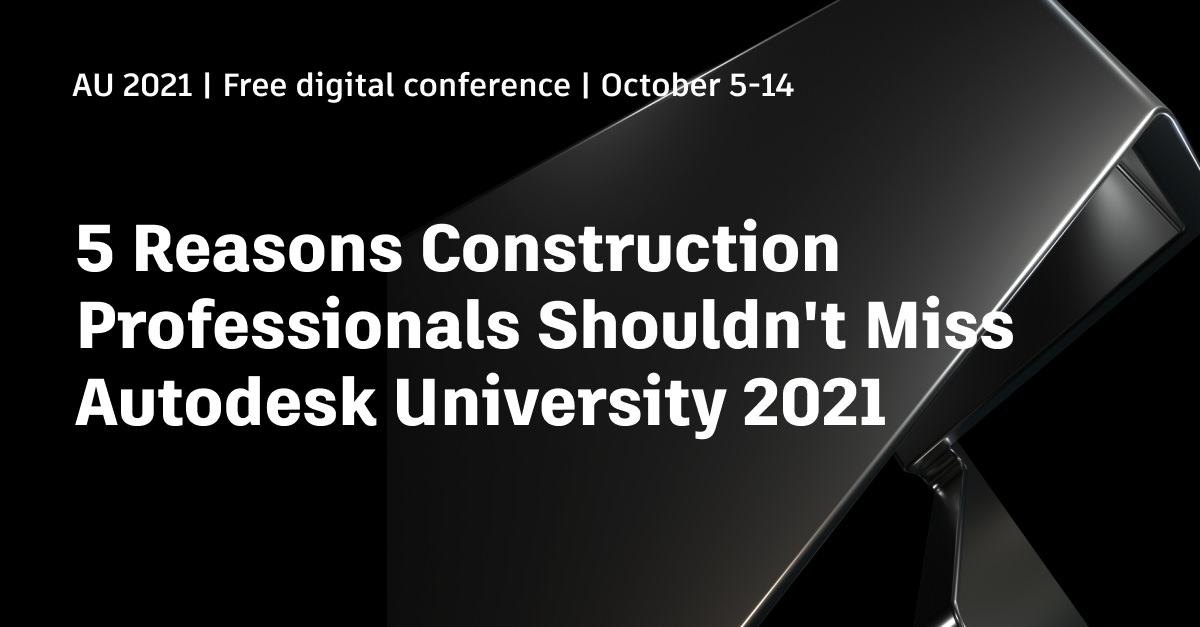
What makes AU 2021 an absolute must for construction professionals? This event is chock full of informative insights, action plans, inspiring thought leadership, and engaging industry panels. Nowhere else will you find so many industry experts advancing architecture, engineering, construction, design, manufacturing, and media and entertainment all in one place. Did we mention it’s 100% free, virtual, and open to all?
Keep reading to discover how to make sure you maximize your time during AU and make the most of this opportunity to learn, connect, and engage.
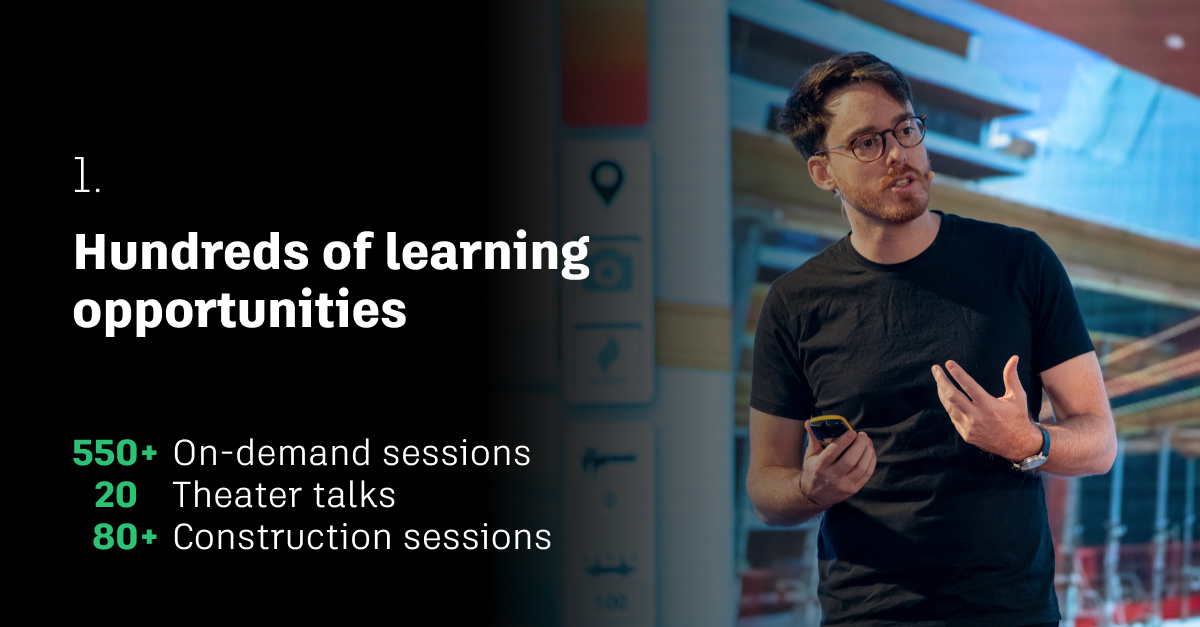
Learn from construction’s finest
We could go on and on about just how many inspiring sessions you’ll find at AU but a quick glance at the numbers makes an even more compelling argument:
- 550+ on-demand sessions
- 20 theater talks
- 80+ construction sessions
We’re not exaggerating when we say this is the biggest learning opportunity of the year for construction professionals. AU sessions will cover popular workflows and topics including:
- Connected construction
- Preconstruction
- Construction, jobsite, and built environments
- BIM
- Industrialized construction
- Diversity & Inclusion
- Sustainability
- And more
You’ll find plenty of information on hot-button subjects such as sustainability in construction and vitally important themes like diversity and inclusion. We’re proud to share that nearly 3 out of every 4 classes at AU are customer-led. That means you’ll learn tricks of the trade from people who have deep industry knowledge and manage construction workflows for projects of all sizes.
Can’t make every session you want to attend? Not to worry. All of the content will be available on-demand. Make sure you register now for access so we can send you the schedule as soon as it’s available.
SAVE YOUR SEAT
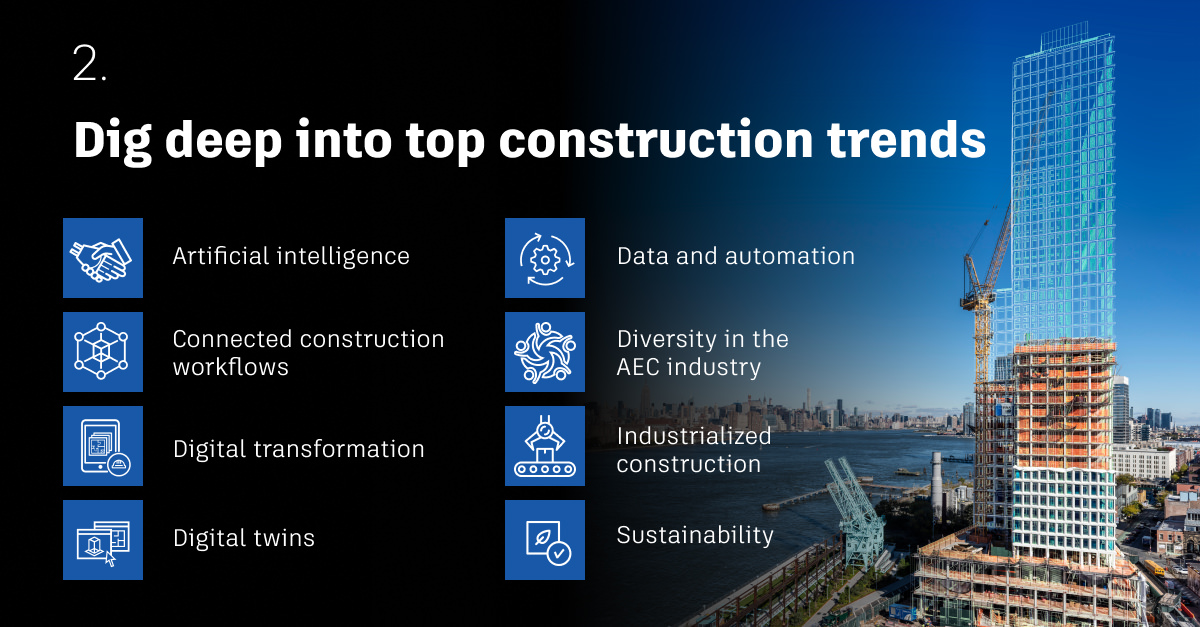
Construction trends you should know about
For an industry that’s often characterized as “traditional,” the construction industry is always changing. It can be difficult to keep tabs on the latest developments and emerging trends such as artificial intelligence, digital twins, and industrialized construction. That’s why we’re bringing them to you in AU 2021, where you’ll learn what is happening right now and how to get on board for the future.
No matter what your role in the industry is, it’s always beneficial to keep a pulse on innovative concepts and technologies. Whether you want to secure that next promotion or drive greater ROI for your client on a large-scale project, you’ll receive the insights you need to bring you one step closer to achieving your goals.
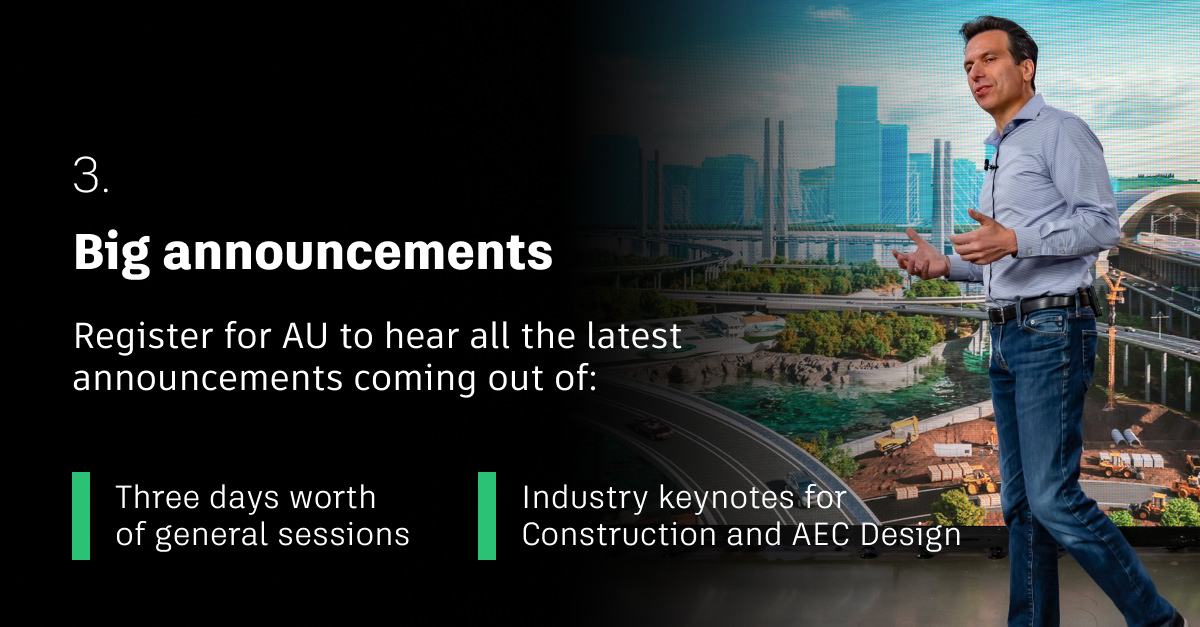
Exciting technology and product news
At AU 2021, you’ll hear exciting news from our general sessions and our keynote with Jim Lynch, SVP & GM of Autodesk Construction Solutions. Put time on your calendar for inspiring thought leadership and insights into how we’re helping empower tomorrow’s leaders of construction—yourself included.
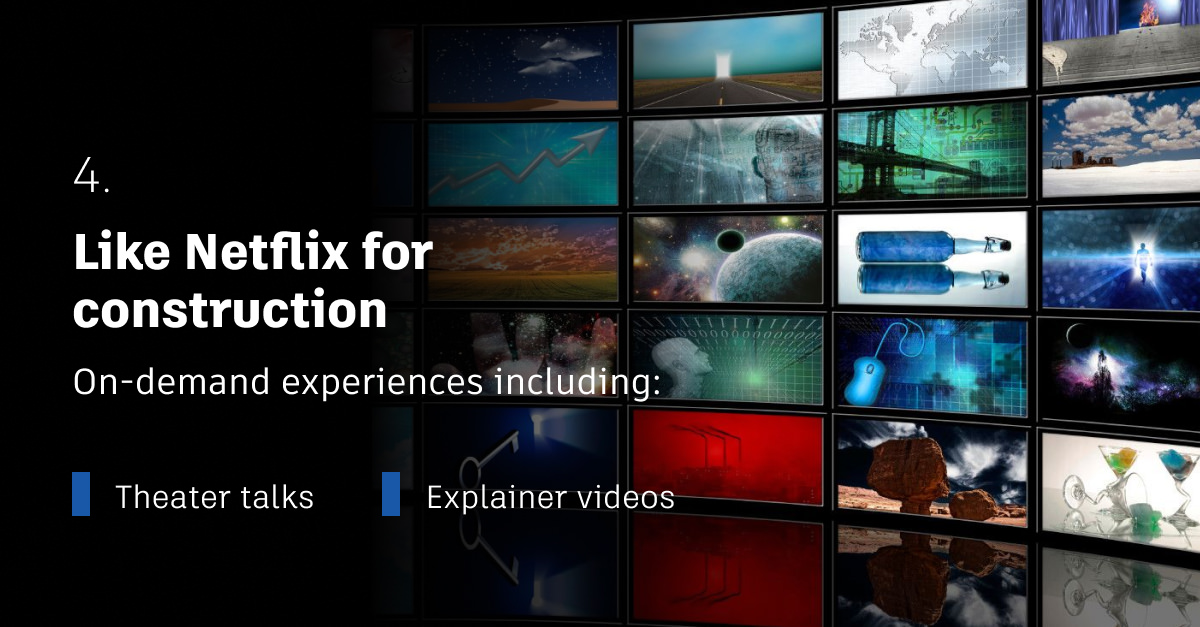
Get exclusive on-demand content
Think of our on-demand content like Netflix but for construction. Press play on our 15-minute theater talks and get ready to jump right into the latest information on industry and technology possibilities. These provocative talks from industry experts are designed to help you explore big ideas and inspirational projects.
AU’s explainer videos are an absolute must for anyone who wants to get into the nitty-gritty of construction. We’ll share the ins and outs of all things construction in a consumable, engaging format. They’re perfect for getting up to speed on highly technical concepts in a flash.
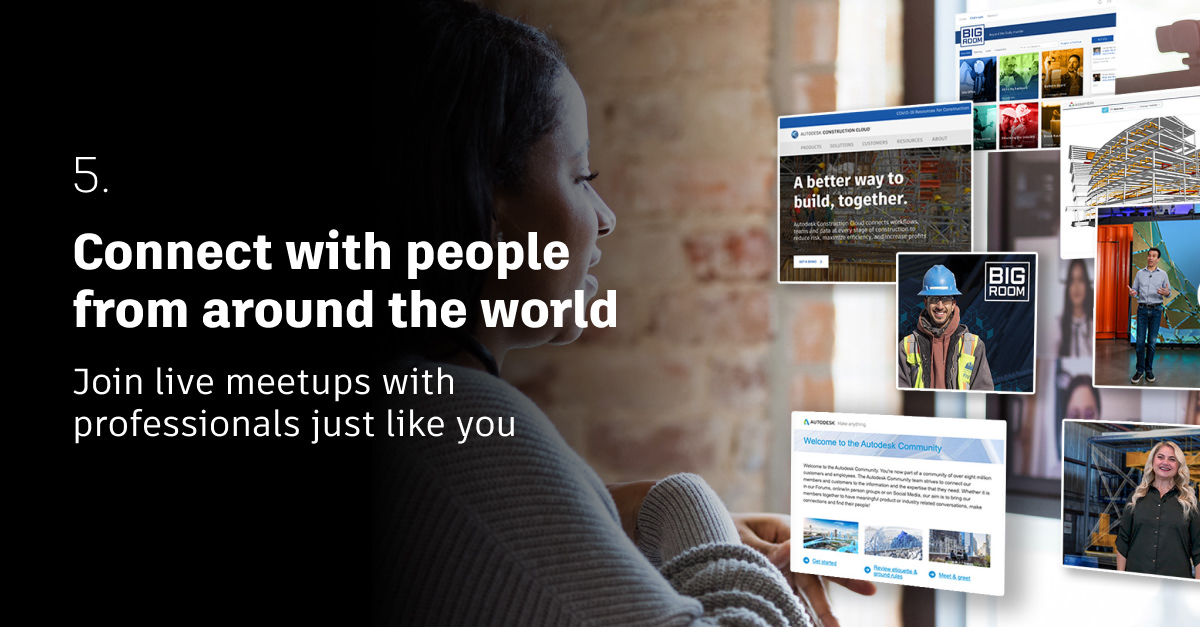
Connect, network, and engage
Sure, AU 2021 is virtual but that won’t stop us from bringing the brightest minds in construction together. We’re providing dozens of opportunities to connect and engage with experts throughout the conference. You’ll love our live meet-ups, which we kicked off at AU 2020, with conversations about everything from design and planning to construction and beyond.
How to make the most out of Autodesk University
Autodesk University only comes around once a year, so it’s important to make the absolute most of it! Here are our time-tested tips and tricks for maximizing your experience:
1. Register early
Did we mention this year’s theme is “Don’t Wait for Progress. Make It.”? The first step in making progress toward your goals is making sure your seat is saved at AU 2021. Don’t wait until October 5 to register. Head to the AU 2021 site now and click on the “Register Now” button. In a matter of minutes, you’ll be registered and ready to consume all of the great classes and content, both live and on-demand.

2. Plan your schedule
Once you’re registered, we’ll send you this year’s full schedule as soon as it’s available. Take a look at the keynotes, theater talks, and sessions ahead of time. Some sessions are only offering limited seating, so please make sure to sign up now so you’re among the first to hear. Once the schedule has been released, bookmark your favorite classes so you can jump right in on October 5. You can get a sneak peek of the schedule on the official AU 2021 website.
3. Make time
Once you’ve registered and picked your sessions, what’s next? Set yourself up for success by making time. Block out your work calendar so you can really immerse yourself in the learning experience. Let your team know about your attendance and invite them to join you. Share far and wide—with 39 countries represented and content in 8 languages, AU 2021 is a must-attend international event for construction professionals.
4. Make space
While this is a virtual conference, we encourage you to take stock of your environment. Do you need to swap out your headphones or adjust your monitors prior to the conference? Can you book a conference room for yourself and team members? Make things as comfortable as possible so on October 5 all you need to do is show up and learn.
The future belongs to those who make it—start building yours at Autodesk University 2021
We’re excited to see you at AU 2021, where you’ll find a wealth of industry knowledge, technology, and education. We’ve said it before, and we’ll say it again—this free, virtual conference is open to all and kicks off on October 5. So what are you waiting for?
REGISTER NOW
The post 5 Reasons Construction Pro’s Should Not Miss Autodesk University 2021 appeared first on Digital Builder.
Did you miss our previous article…
https://www.arizonasolarsociety.com/?p=430
What Are As Built Drawings?
If a picture can speak a thousand words, in a project, as-built drawings can speak a thousand construction processes. But in all seriousness, with the hundreds and thousands of steps and documents needed to complete just one project, as-builts might be overlooked for their importance. Nonetheless, as-built drawings remain an essential process in a project, especially to maintain a project’s lifecycle after construction has ended.
Despite this, as-builts are often not included, or are only addressed right at the end when an accurate product is far less achievable because of a failure to record changes to the project along the way. Below, we provide a thorough look at what as-built drawings are, who creates them and why they’re important. We’ll also offer a roundup of the most critical items to include in each as-built drawing.
What Is an “As-Built?”
Also known as record drawings and red-line drawings, as-builts drawings are documents that allow a compare and contrast between the designed versus final specifications, and provide a detailed blueprint of the building and the land around it as actually constructed in the end. According to Business Dictionary, as-builts are a “revised set of drawings submitted by a contractor upon completion of a project or a particular job. They reflect all changes made in the specifications and working drawings during the construction process, and show the exact dimensions, geometry and location of all elements of the work completed under the contract.”
The final as-built drawings include any and all of the following, as well as every other change made during the construction phase of a project:
- Modifications
- Field changes
- Shop drawing changes
- Design changes
- Extra works
As-built drawings go hand-in-hand with as-built surveys, also called as-built maps. These are used during the construction phase to continually track how the land and building is changing as work progresses. Dedicated as-built surveys make as-built drawings much easier to construct in the end, because of the greater level of detail recorded from every stage of the project.
Who Creates As-Built Drawings?
Typically, the architects or designers who originally designed the project will also create the as-builts. They are familiar with the original specifications and are therefore the most qualified to reflect recorded changes. According to Cornell University Facilities Services, the people in charge of as-built drawings differ depending on whether the design job is in-house or from an external party, like the contractor:
“For in-house design jobs … these could be put together by anyone on the design team or the shops,” whereas for “out of house design jobs … the drawings are put together by the contractor, typically with the assistance of sub-contractors for submittal to the architect for inclusion in the record drawings.”
As mentioned, as-builts on a whole are much easier to accomplish with detailed notes from every phase of construction. Because truly useful as-builts require so many nitty gritty details, it’s simpler to use technology to record changes along the way than it is to try to recover the details of those changes afterward. One helpful tool to detail changes is mobile technology powered by construction software to enable you to track adjustments immediately, avoiding loss of changes and errors in recording them.
Why Are As-Builts Important?
While submitting as-built drawings is not necessarily a must on every job, it’s a helpful component to any completed project, and if completed correctly, reflects well on your company’s professional image. As the Construction Management Association of America explains:
“They are important for those who use the finished product, as they provide a legacy of what was actually built. This legacy becomes more important, as we continue to build on top of old work, land ownership changes or for public works, as employees familiar with what was-built are replaced over time by attrition.”
As-builts, in other words, ensure that as designers, architects and contracts move on from the project and, a resource still exists beyond the original blueprints.
Overall, as-builts are important for four main reasons:
- Improves onboarding: As subcontractors are added to a project, delivering a set of as-builts helps teams get access to the right information quickly, which allows getting up to speed starting work sooner.
- Assists the facilities team: With a full record of change, facility teams can meet issues faster and owners can save money down the road due to improved operations and speed
- Streamlines permitting process: Oftentimes, government agencies request sets of as-builts in order to issue building permits.
- Improves the renovation process: With a full history of project changes, owners can see exactly what has been built and do not have to invest heavily in learning about existing conditions
Why Should Contractors Care?
If you’re a general contractor, you might be thinking, “why should I prioritize as-builts at the end of a project?” The truth is, you shouldn’t just focus on creating as-builts; you should strive to elevate the quality of the packages you provide, too.
Good as-builts drawings can do wonders to improve your reputation as a company and increase your business in the long-term. If you’re a subcontractor, as-builts can be especially important as you might be hired for system maintenance and renovations. At this point, the information and data found in packages won’t just benefit owners, it will benefit your ability to successfully complete a job.
Looking to learn more about how to create quality as-built drawings? Read on.
What Should Be Included in As-Builts?
In order to make your as-builts as clear and useful as possible, you must include a wide variety of details and documents. This information includes, but is not limited to:
- Recording changes in scale, or ideally using the same scale as the original drawings
- Using clear labels and descriptions rather than vague phrases such as “similar” or “equal to”
- Including changes in sizing, materials, dimensions, location, installation, fabrication and so on
- Noting unexpected obstructions encountered, and the solutions decided upon
- Noting dates when changes were made
- Recording any changes made as a result of final inspection
- Attaching all related shop drawings and appendices
Obviously, this is a significant amount of information to include and needs a great deal of detail to be recorded along the way. Although this can seem like a daunting and time-consuming prospect, it’s presumably less intimidating than telling a client no as-builts are available, or turning in shoddy work that does not serve them (or your chances of getting rehired) in the long run. Nonetheless, mobile technology can assist in putting this record process in practically auto-drive.
Where As-Builts Fall Short Today
If the goal is to improve as-builts, then we must pinpoint where they’re falling short today. Otherwise, it’s impossible to address the real problem where it lies. So what’s the issue? In the long run, it comes down to inadequate documentation. As we saw in the case of Burlington mall, missing information is a common reason why projects get delayed or halted.
Too many as-builts exhibit missing information and errors, at least partially due to a lack of commitment on the construction team’s part. Today’s as-builts:
- Often lack the right kind of documentation
- Fail to back up statements with photographic evidence or drawings
- Don’t capture data at a deep enough level
- Don’t effectively provide for later updates and additional documentation
- Frequently are disorganized, making it nearly impossible to sort through the information
Again, a lot of this is due to missing motivation and commitment. To capture the needed and accurate information that quality as-builts rely on, teams must go into a project intending to do just that.

6 Solid Strategies to Improve As-Builts
So now that you understand why they’re important and where they frequently fall short today, it’s time to kick your as-builts game up a notch. Here are six next-level strategies to help you do just that.
1. Set As-Builts Up for Success Before Construction Begins
As we mentioned, a reason why teams fail to create detailed and accurate as-builts is that no system was set up for success in the first place. The worst thing teams can do is to try to create a complete set of as-builts drawings at the end of construction. Instead, before construction begins, there needs to be a place where data can be captured, stored, edited and distributed throughout the process. If there isn’t, then we can’t blame teams for failing to do so.
Luckily, there’s a solution: To improve as-builts and boost productivity, nothing can beat the cloud to store project plans and updates. With easy digital access to as-builts from anywhere, you can ensure all changes are captured and recorded. That means teams can add the necessary documentation out in the field, from phones and tablets, rather than waiting until they get back to the office and trying to remember all the crucial details or transcribe them from field notes.
With cloud access from the start of a project, snapping photos, jotting notes and uploading everything on the spot becomes a cinch and creates more accurate as-builts as a result.
2. Make High-Quality As-Builts Part of the Project Culture
There’s no way to improve as-builts if management is not on board. That’s why it’s so important to create a culture behind data capture, which will ensure not only that you maintain as-builts as you go along but that they are of the highest possible quality. This is easier said than done, and it starts with educating teams on why as-builts matter, training them on how to create them and setting expectations that they will be completed to certain standards.
Teams should know why and how to input the data into the primary document system. There should be specific workflows and protocols set up by a project administrator also to standardize this.
3. Go Deep With Data
Quality of data matters in as-built drawings–and the more, the better. There are tools and technology to increase the capture of data to help O&M and future construction teams and to improve as-builts, you must make use of them. To create better as-built drawings, it helps to utilize technology that gets you a high level of project data from the start. Three of the best technologies today include:
- Laser Scanning: This is a tool that’s particularly useful for site surveying, measuring measures millions of points within a 360-degree space. This survey tool makes it possible to quickly and accurately measure the distance between two points, saving loads of time in the planning and prepping stages. The data can be used throughout the construction process to collect data for as-built drawings.
- Building Information Modeling: BIM data–captured from both design and construction–is essential to include in the as-built, which are called “as-built models” in BIM. High-quality information can be used, as well as updated, for teams to visualize components and products in a facility when they have to make repairs or conduct maintenance.
- Connected Construction Data: Have you ever lost critical project data? Poor interoperability of systems and lost data adds up – equating to nearly $11 billion annually for owners. To build high-quality as-builts, teams cannot afford to have any data slip through the cracks. Connected construction software platforms help to ensure data is retained. For instance, Autodesk Construction Cloud
 enables all building information –assets, documents, models, and more – be gathered, organized, and turned over to the owner, so they are “ready on day one” to operate the building. With all the information at their fingertips, facilities managers have a comprehensive digital record set in one easy-to-access place to manage all building maintenance and operational needs efficiently. Even when it’s time for future renovations or rebuilds, the connected construction technology provides all the information owners need to make cost-effective and data-driven.
enables all building information –assets, documents, models, and more – be gathered, organized, and turned over to the owner, so they are “ready on day one” to operate the building. With all the information at their fingertips, facilities managers have a comprehensive digital record set in one easy-to-access place to manage all building maintenance and operational needs efficiently. Even when it’s time for future renovations or rebuilds, the connected construction technology provides all the information owners need to make cost-effective and data-driven.
4. Include Photos
A picture is worth a thousand words, and if we kept that in mind, we could increase the detail and effectiveness of as-builts immediately.
While construction relies heavily on drawings, and they’re not going anywhere anytime soon, they can’t always capture everything that a photo can. To paint an accurate picture of what a project’s existing facilities contain, there’s nothing better than construction photos.
Even better: When photos contain GPS data, they also provide an additional and extremely valuable level of detail to as-built drawings. Facilities teams can use this data to see exactly where the location of a photo is to a drawing–especially important when teams are looking at complicated systems behind walls, or in otherwise hard-to-get locations.
5. Create “Living” As-Builts
If we want to improve as-builts, we need to wrap our heads around the fact that, much like a living organism, a building changes from day to day. Renovations and changes are made all the time. Even small adjustments matter to a building’s future makeup.
Therefore, a project’s as-built drawings shouldn’t remain static; there needs to be an avenue to update and adapt them from the start. That requires that as-builts:
- Be available to anyone who needs them, from future construction teams to O&M staff
- Be accessible from anywhere, which means they need to be in the cloud
- Permit stakeholders to update and provide future documentation
- Allow linking between documents so you can easily connect a sheet to the RFI it references
With these factors in mind, it’s possible to preserve the quality and integrity of the building over its lifespan through as-builts.
6. Keep in Mind that Presentation Matters
Appearances matter. We instinctively know this, which is why we wear nice clothing to interviews and put sprigs of parsley on platters of fish. Yet too few construction teams bring this innate human emphasis on presentation to as-builts, and that has to change.
For contractors, exporting a disorganized turnover package with as-built drawings not ordered reflects poorly on them. To be useful, as-builts should be organized and searchable, across time, trade and file formats. This can be achieved with the right construction software platform.
Construction software, such as Autodesk Build, can help teams assemble and export organized as-builts that owners and facility teams can easily access and utilize. Not only does this simplify O&M efforts later and add value to a project, but it can also help contractors themselves do better business if they’re hired for a renovation or addition project down the road.
Use Technology to Produce Better As-Builts
If you’d like to create the highest quality as-builts, then utilizing mobile technology is your best option. The right construction technology will enable you to record all field changes in real time, helping you to quickly review and apply that information to your resulting as-built. Taking that need a step further, we created the As Built Export tool for Autodesk Build—allowing your handover process to go much smoother.
One major thing to keep in mind when choosing construction technology to assist with the creation of as-builts is to choose a technology solution that prioritizes data portability. Data portability means that all the data generated from the construction process is available both physically and digitally to the facility maintenance team who will be accessing it. In short, this accurately helps ensure that this is one source of truth.
So, don’t spend any more time fearing as-builts—with the right knowledge and tools, you can successfully (and painlessly) capture an accurate snapshot of your entire construction project.

The post What Are As Built Drawings? appeared first on Digital Builder.
Did you miss our previous article…
https://www.arizonasolarsociety.com/?p=425
London secures £3.46bn affordable homes grant – list
The London Mayor has secured £3.46bn to deliver 29,456 homes with councils and housing associations from the first round of bidding for the next five-year affordable homes programme.
These fresh grants cement the council housing comeback in London, with more than four in 10 of the homes being built by councils, totalling 12,024 homes.
More than half of the social rented homes will be built by councils, and 57% of all homes will be for social rent.
A further £5.2bn was announced by the Government today for affordable homes to be delivered outside London by Homes England, but details have yet to be released.
The Mayor’s new 2021-26 programme – running alongside the extended 2016-23 programme – will see 79,000 new homes started over the next five years.
In total, almost six in ten of the homes (16,739 homes) funded by the first round of this affordable homes programme will be made available at the cheapest social rent.
The remainder will be for shared ownership and London Living Rent which can help Londoners on average incomes move into homeownership.
The Mayor has set ambitious targets for London to be a zero-carbon city by 2030 and expects homes built with funding announced today to be environmentally sustainable.
New standards introduced in the Mayor’s New London Plan include requirements for all developments of ten or more homes to be net zero-carbon and to incorporate sustainable urban green spaces.
Housing providers building homes funded by the new AHP will also have to meet new conditions on building safety and design.
AHP funding project conditions
1. The installation of sprinklers or other fire suppression systems in new blocks of flats
2. A ban on combustible materials being used in external walls for all residential development, regardless of height
3. Minimum floor-to-ceiling heights and a requirement for private outdoor space
4. A ‘sunlight clause’ requiring all homes with three or more bedrooms to be dual aspect, any single aspect one- or two-bedroom homes to not be north-facing and at least one room to have direct sunlight for at least part of the day
The Mayor of London, Sadiq Khan said: “I am delighted that we have been able to come to a deal with the Government to get started on nearly 30,000 genuinely affordable homes.
“Today’s funding is good news but I know we can still go further, faster, working with ministers, housing associations and councils to deliver more of the homes Londoners so desperately need.”
Did you miss our previous article…
https://www.arizonasolarsociety.com/?p=424
Improve Handover with New, Easy-to-Use As-Built Export in Autodesk Build
During the handover phase at the end of a project, construction teams are often asked to provide as-built sets, which typically includes document drawings, RFI’s, and submittals. These as-builts can also be helpful during construction if teams need to onboard a new subcontractor or if a third party, like a local planning authority, requests this type of information in order to obtain a building certificate.
When it comes to putting together as-builts, it can be a very manual and time-consuming process. It’s difficult to track down and find all the related documents and versions needed and even harder to organize all of these files into easily consumable packages. Lastly, when you are doing all of this manually or in one-off exports, teams end up with a bunch of disconnected PDF’s making it harder for the recipient to find relevant information as they look through it (e.g. finding which sheet markups relate to which RFIs).
With the new As-Built Export tool in Autodesk Build, Project Admins can easily generate a set of as-builts including sheets, RFIs and submittals, then export for use in handover packages or other third party-requested deliverables. This feature will help eliminate time-consuming manual processes by:
Improve your Handover process with the As-Built Export feature
- Streamline the approval process of all handover materials
- Allow for improved collaboration and communication with owners during the handover process
- Improve onboarding for new subcontractors
- Better manage handover with filter, sort, and tracking capabilities
- Find relevant handover information much quicker from both internal teams as well as subcontractors
- Maintain connectivity with links between PDF sheets and RFI’s
- Have a reliable way to backup and archive your sheets, RFIs and submittals project data
See the As-Built Export tool in action
Key Benefit of the As-Built Export Tool:
Instant accessibility to as-built information
With the ability to easily aggregate as-built information, teams no longer need to waste valuable time at the end of a project digging through files and drawings to find the latest version.
Improved accuracy and speed of handover
With the ability to filter and automatically pull the right documents, teams will improve both the accuracy of information included in the handover package as well as the overall speed of getting handover done.
Improved owner satisfaction & repeat work
When construction teams deliver as-builts with all the right information organized in an easily consumable way, owners are happier and more likely to do repeat work with the GC. Facilities teams also get what they need to confidently operate the building from Day One.
Request a demo
At the end of the day, we’re all working towards finding a better way to do what we already do. The As-Built Export Tool for Autodesk Build does exactly that. It’s a surefire way to make handover a much smoother process while enabling project stakeholders to easily supply important project information to third party requesters. If you’d like to request a demo, please contact us.
Please note for EMEA customers, this feature is a bit delayed and will be available by mid-September.
The post Improve Handover with New, Easy-to-Use As-Built Export in Autodesk Build appeared first on Digital Builder.
Did you miss our previous article…
https://www.arizonasolarsociety.com/?p=418